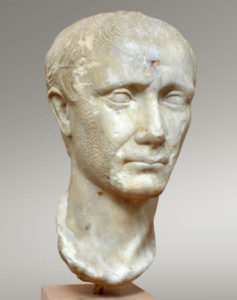Κόρινθον δὲ οἰκοῦσι Κορινθίων μὲν οὐδεὶς ἔτι τῶν ἀρχαίων, ἔποικοι δὲ ἀποσταλέντες ὑπὸ Ῥωμαίων. αἴτιον δὲ τὸ συνέδριον τὸ Ἀχαιῶν: συντελοῦντες γὰρ ἐς αὐτὸ καὶ οἱ Κορίνθιοι μετέσχον τοῦ πολέμου τοῦ πρὸς Ῥωμαίους, ὃν Κριτόλαος στρατηγεῖν Ἀχαιῶν ἀποδειχθεὶς παρεσκεύασε γενέσθαι τούς τε Ἀχαιοὺς ἀναπείσας ἀποστῆναι καὶ τῶν ἔξω Πελοποννήσου τοὺς πολλούς. Ῥωμαῖοι δὲ ὡς ἐκράτησαν τῷ πολέμῳ, παρείλοντο μὲν καὶ τῶν ἄλλων Ἑλλήνων τὰ ὅπλα καὶ τείχη περιεῖλον ὅσαι τετειχισμέναι πόλεις ἦσαν: Κόρινθον δὲ ἀνάστατον Μομμίου ποιήσαντος τοῦ τότε ἡγουμένου τῶν ἐπὶ στρατοπέδου Ῥωμαίων, ὕστερον λέγουσιν ἀνοικίσαι Καίσαρα, ὃς πολιτείαν ἐν Ῥώμῃ πρῶτος τὴν ἐφ᾽ ἡμῶν κατεστήσατο: ἀνοικίσαι δὲ καὶ Καρχηδόνα ἐπὶ τῆς ἀρχῆς τῆς αὐτοῦ.
- Map
- Pre Reading
- Post Reading
- Culture Essay
Rome’s interest in Corinth and Isthmia begins at least as early as 196 BCE when the Roman general Flamininus declared at the Isthmian Games that Greece was “free” from the yoke of Philip V and the Macedonians. Emboldened by Macedon’s defeat, the Achaean League, under the leadership of Philopoemon, defeated Sparta in 188 BCE. Yet it did not take long before the Greeks of the Achaean League grew weary of Roman rule, too. In 146 BCE under the leadership of Critolaus, the Greeks attempted to rebel, but were crushed by the Roman general Lucius Mummius and the city of Corinth was sacked.
Places Named in Pausanias’ description of Corinth (Google Earth): Corinth, Isthmia, Rome, Carthage
